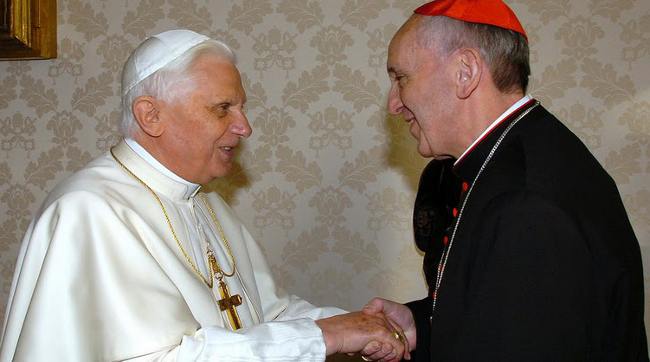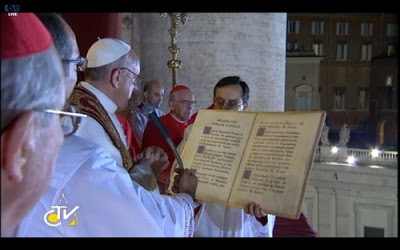Brothers and sisters, hello!
After the first meeting last Wednesday, today I can again offer my greeting to everyone! And I am glad to do it on Sunday, the Lord’s day! This is beautiful and important for us Christians: coming together on Sunday, greeting each other, talking with each other like we are doing now here in the piazza; a piazza that, thanks to the media, has the dimensions of the world. On this fifth Sunday of Lent, the Gospel presents us with the episode of the adulterous woman (cf. John 8:1-11), who Jesus saves from the death sentence.
Jesus attitude is striking: we do not hear words of scorn, we do not hear words of condemnation, but only words of love, of mercy, that invite us to conversion. Neither do I condemn you: go and sin no more! (8:11). Well, brothers and sisters, the face of God is that of a merciful father, who always has patience. Have you thought about God’s patience, the patience that he has for each of us? That is his mercy. He always has patience, patience with us, he understands us, he waits for us, he does not weary of forgiving us if we know how to return to him with a contrite heart. Great is the mercy of the Lord, the Psalm says.
These last several days I have been able to read a book by a cardinal, Cardinal Kasper, a smart theologian, a good theologian on mercy. And it did me much good that book, but dont think that I am advertising the books of my cardinals! It is not that way! But it did me much good, much good… Cardinal Kasper said that hearing the word mercy, this word changes everything. It is the best word we can hear: it changes the world. A little mercy makes the world less cold and more just. We need to rightly understand this mercy of God, this merciful Father, who has a lot of patience … Let us remember the prophet Isaiah, who says that even if our sins are bright red, God’s mercy can make them white as snow. Mercy is beautiful!
I remember, when I had just become a bishop, in the year 1992, Our Lady of Fatima had just arrived in Buenos Aires and there was a big Mass for the sick. I went to hear confessions at that Mass. And near the end of the Mass I got up, because I had to administer holy oil.
An old lady came to me, a humble lady, very humble, over 80 years old; I looked at her and I said to her: Grandma, because in our country this is what we call old people: ‘Grandma do you want to go to confession?’ ‘Yes,’ she said to me. But if you havent sinned…, [I said]. And she said to me: We have all sinned… . ‘But maybe the Lord does not forgive them’… [I replied].
The Lord forgives everything, she told me, certain of what she was saying. But how do you know that, madam? If the Lord did not forgive everything, [she said], the world wouldnt exist. I felt like asking her, Tell me, madam, did you study at the Gregorian? because thats the wisdom that the Holy Spirit gives: interior wisdom about the mercy of God.
Let us not forget this: God never wearies of forgiving us, never! So, father, whats the problem? Well, the problem is that we grow weary, we do not want to, we tire of asking for forgiveness. He never tires of forgiving, but we, at times, we tire of asking forgiveness. Let us never tire, let us never tire! He is the loving Father, who always forgives, who has that heart of mercy for all of us. And we too learn to be merciful with everyone. We invoke the intercession of Our Lady who held in her arms the Mercy of God made man. Now let us all together pray the Angelus. [Following the recitation of the Angelus, the Holy Father greeted those present in Italian.]
I offer a cordial greeting to all the pilgrims. Thanks for your welcome and for your prayers. I ask you to pray for me. I renew my embrace of the faithful of Rome and I extend it to all of you, who come from various parts of Italy and of the world, and to those who are joining through different media. I chose the name of the Patron of Italy, St. Francis of Assisi, and that reinforces my spiritual bond with this land, where as you know my family has its origins. But Jesus has called us to be part of a new family: his Church, this family of God, walking together along the way of the Gospel.
May the Lord bless you, may Our Lady protect you. Do not forget this: the Lord never wearies of forgiving! We are the ones who weary of asking for forgiveness. Have a good Sunday and a good lunch!





